Observing the Moon: Tour Guides Wanted
Jack Kramer
Let's suppose a guide on one of the boats that ply the Chicago River were giving visitors an architectural tour of the city. Consider the following dialog.
Guide: "There's a building."
Visitor: "Which one?"
Guide: "The big one."
Visitor: "They're all big."
Guide: "The white one with the pointy top."
Visitor: What's it called?"
Guide: "I think it's the Wrigley Building. Has something to do with gum."
It seems that on occasion we do something like that when showing the moon to visitors at a public star party. We're used to letting the "wow" factor of all those craters carry the show. To some extent, we're not really to blame. Many of us are more interested in the planets and deep sky objects. For the most part, the moon just gets in the way. Yet people really do enjoy looking at the moon, especially under high magnification.
To be effective tour guides, we need to become familiar with interesting features at the different phases and be able to point out some aspects of them. But I don't think it's necessary to quote a lot of statistics like width of the craters and heights of mountains, which can become pretty boring. One question that many visitors ask is how small an object you can see with your telescope. On a good night with high magnification on my 4-inch refractor, I can detect objects around three to four miles in diameter. For detailed info, there are several books and maps that serve as an observing guide to the moon. Also, "Observing the Moon" articles from past newsletters are archived on the LCAS web site.
Perhaps one of the more interesting aspects of the moon is the issue of how the features came to be formed in the moon's early days. What shaped the topography that we see today? In a few cases astronomers disagree about the specifics. Here are some of the things to point out about various features.
Craters
As everyone knows, craters are impact features, formed when the young moon was being bombarded by debris from the formation of the solar system. Some experts believe that cratering may still be occurring, though on a much smaller scale. (During the 2001 Leonid meteor storm, astronomers observed flashes on the Moon - telltale signs of meteoroids hitting the lunar surface and exploding.) The floors of some craters are very smooth, covered with the same material that we see in the mare - the lunar "seas". This was molten magma that either pushed to the surface within the crater or spilled into the crater from the adjacent mare. In some cases we see where this molten material breached one of the low crater walls, especially in the older, eroded craters.
Mare Nectaris contains several good examples. In the following image we can tell that Theophilus is a young object, as indicated by the sharpness of the crater walls. Adjacent to it is Cyrillus, which is somewhat older. Next is Catharina, which we see is still older based on the highly eroded condition of the crater walls. Nearby is Fracastorius, an example of a crater that was flooded by molten magma which breached its north wall.
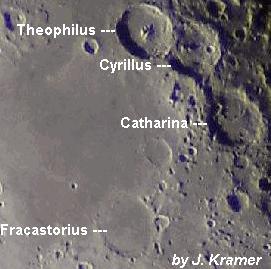
Another way to demonstrate the relative ages of craters is when a crater has one or more other craters within it. There are many such craters, but perhaps the best known is the massive Clavius. This crater is so large, in fact, that in following the curvature of the moon's surface, the center of the floor casts a shadow of its own. Thus when near the terminator, Clavius can have shadows near both the east and west walls, as seen in the image below.
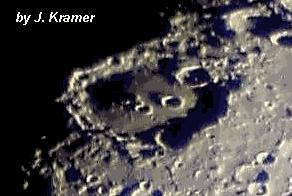
An indicator of the impact origin of craters is ejecta - the system of rays emanating from many craters. Some are long and straight while others are short and sinewy. The cause of this difference is not well understood, and rays are a subject of much study in their own right.
Rills
Rills, or Rimae, are thin trenches that are depression features - places where the crust has subsided perhaps due to subsurface molten lava channels or a shifting of the lunar crust. In our scopes they appear as cracks in the surface. The following image shows that the Ariadaeus Rill passes over and through several other features, indicating that it's a newer object.
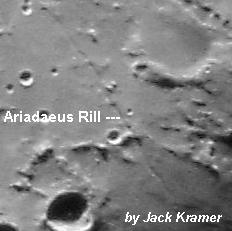
Unique Features
Among the craters, maria, rays and rills covering the lunar surface, there also are a couple of prominent singular features - the Alpine Valley and the Straight Wall. They provide dramatic illustrations of forces that shaped the lunar topography.
The Alpine Valley has been the source of much debate among astronomers. What caused this prominent cleft in the lunar Alps? Is this a massive subsidence feature?
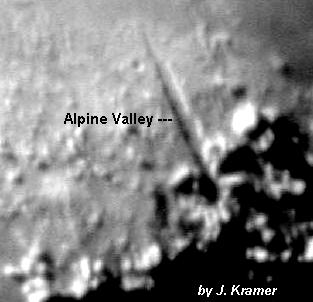
High-resolution images reveal a rill running just about the full length of the floor of the Alpine Valley. But there is another theory that suggests a large piece of ejecta, perhaps from the crater Copernicus, plowed through the Alps, gouging out this valley.
The Straight Wall appears as a nearly straight black line a couple of days after first quarter when this upraised shelf casts a shadow on the surface. Near last quarter, this line becomes a white streak as the sun now shines directly on the uplifted face of the shelf. The wall was apparently formed when a major section of the moon's crust subsided due to forces unknown.
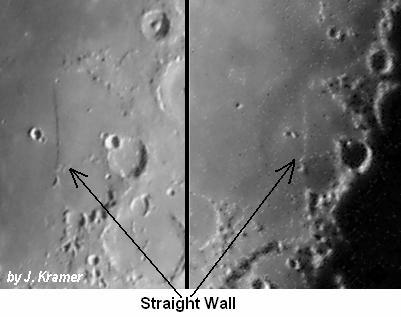
The monkey is now on your back to become familiar with the various features, know where to find them and what to look for. The first step is to get a good lunar atlas. In the process of becoming a better tour guide, you may actually gain more enjoyment out of the moon yourself!
I took the pictures in this article through a 4-inch refractor, so all these features should be visible in your telescopes.
Astro-Dictionary: Radiant
The radiant of a meteor shower is the point in the sky from which meteors appear to originate. If you were to draw lines back along the meteor trails, they would point to this area. The names of annual meteor showers come from the constellation where the radiant lies. When viewing a meteor shower, you don't have to face the direction of the radiant; most of the meteors will not be seen near the radiant, but elsewhere in the sky.
Published in the March 2002 issue of the NightTimes




